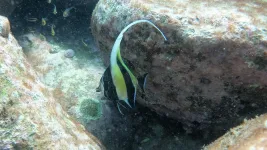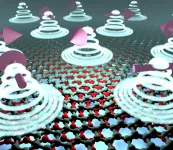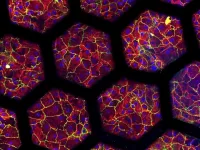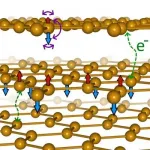UMass Amherst researchers gain insight into the biology of a deadly fungus
Bd's actin structures likely play roles in causing skin disease threatening amphibians worldwide
2021-02-08
(Press-News.org) Researchers at the University of Massachusetts Amherst have gained new insight into the biological processes of a chytrid fungus responsible for a deadly skin infection devastating frog populations worldwide.
Led by cell biologist Lillian Fritz-Laylin, the team describes in a paper published Feb. 8 in Current Biology how the actin networks of Batrachochytrium dendrobatidis (Bd) also serve as an "evolutionary Rosetta Stone," revealing the loss of cytoskeletal complexity in the fungal kingdom.
"Fungi and animals seem so different, but they are actually pretty closely related," says Fritz-Laylin, whose lab studies how cells move, which is a central activity in the progression and prevention of many human diseases. "This project, the work of Sarah Prostak in my lab, shows that during early fungal evolution, fungi probably had cells that looked something like our cells, and which could crawl around like our cells do."
Chytrids including Bd encompass more than 1,000 species of fungi deep on the phylogenetic, or evolutionary, tree. The researchers used chytrids, which share features of animal cells that have been lost in yeast and other fungi, to explore the evolution of actin cytoskeleton, which helps cells keep their shape and organization and carry out movement, division and other crucial functions.
Prostak, a research associate in Fritz-Laylin's lab, is the lead author of the paper, which she initially wrote as her undergraduate honors biology thesis, the expanded and finished the research after graduation. Other authors are Margaret Titus, professor of genetics, cell biology and development at the University of Minnesota, and Kristyn Robinson, a UMass Amherst Ph.D. candidate in Fritz-Laylin's lab.
"Bd is more closely related to animal cells than more typically studied fungi so it can tell us a lot about the animal lineage and the fungal lineage and can also provide a lot of insight into human actin networks," Prostak says. "We can use it to study animal-like regulation in a similar system rather than actually studying it in animal cells, which is very complicated because animal cells have so many actin regulators."
The research team used a combination of genomics and fluorescence microscopy to show that chytrids' actin cytoskeleton has features of both animal cells and yeast. "How these complex actin regulatory networks evolved and diversified remain key questions in both evolutionary and cell biology," the paper states.
The biologists explored the two developmental stages in Bd's life cycle. In the first stage, Bd zoospores swim with a flagellum and build actin structures similar to those of animal cells, including pseudopods that propel the organisms forward. In the reproductive stage, Bd sporangia assemble actin shells, as well as actin patches, which are similar to those of yeast.
The disease chytridiomycosis, caused by Bd, ravages the skin of frogs, toads and other amphibians, eventually leading to heart failure after throwing off fluid regulation. This disease has been attributed to huge losses of biodiversity, including dozens of presumed population declines and extinctions over the past 50 years, though exactly how many species have been affected by this disease has been subject to debate.
The UMass Amherst biologists say Bd's actin structures they observed likely play important roles in causing the disease. "This model suggests that actin networks underlie the motility and rapid growth that are key to the pathology and pathogenicity of Bd," the paper concludes.
Prostak, an animal lover drawn to Fritz-Laylin's lab because of its focus on pathogens, hopes their research advancing the knowledge about Bd will lead to measures that slow the deadly damage of chytridiomycosis.
"Figuring out the basic biology of Bd will hopefully give insight into disease mitigation in the future," Prostak says.
INFORMATION:
[Attachments] See images for this press release:

ELSE PRESS RELEASES FROM THIS DATE:
2021-02-08
The findings are published in the prestigious journal, Nature Climate Change, and calls on businesses, the financial services industry and regulators to work more closely with climate scientists.
Regulators and governments - both domestic and international - are increasingly requiring that businesses assess and disclose their vulnerability to the physical effects of climate change, for example, increased drought, bushfires and sea level rise.
"People are making strategically material decisions on a daily basis, and raising debt or capital to finance these, but the decisions may not have properly considered climate risk," said lead author Dr Tanya Fiedler from the University of Sydney Business School. ...
2021-02-08
Under increasing global warming, tropical fish are escaping warmer seas by extending their habitat ranges towards more temperate waters.
But a new study from the University of Adelaide, published in Nature Climate Change, shows that the ocean acidification predicted under continuing high CO2 emissions may make cooler, temperate waters less welcoming.
"Every summer hundreds of tropical fish species extend their range to cooler and temperate regions as the waters of their natural habitat become a little too warm for comfort," says lead author Ericka Coni, PhD student in the University's School of Biological Sciences. "For at least two decades, Australian temperate reefs have been receiving new guests ...
2021-02-08
Recycling cans and bottles is a good practice. It helps keep the planet clean.
The same is true for recycling within cells in the body. Each cell has a way of cleaning out waste in order to regenerate newer, healthier cells. This "cell recycling" is called autophagy.
Targeting and changing this process has been linked to helping control or diminish certain cancers. Now, University of Cincinnati researchers have shown that completely halting this process in a very aggressive form of breast cancer may improve outcomes for patients one day.
These results are published in the Feb. 8 print edition of the journal Developmental Cell.
"Autophagy is sort of like cell cannibalism," ...
2021-02-08
BUFFALO, N.Y. -- In cells, numerous important biochemical functions take place within spherical chambers made from proteins and RNA.
These compartments are akin to specialized rooms inside a house, but their architecture is radically different: They don't have walls. Instead, they take the form of liquid droplets that don't have a membrane, forming spontaneously, similar to oil droplets in water. Sometimes, the droplets are found alone. Other times, one droplet can be found nested inside of another. And these varying assemblies can regulate the functions the droplets perform.
A study published on Feb. 8 in Nature Communications explores how these ...
2021-02-08
Some coronaviruses can add to their genetic pool some genes belonging to the host they infected. In this way, they can blend in and be less detectable to the immune system. This discovery was published in the journal Viruses by an Italian research team from the IIS (Italian Healthcare Institute), ISPRA (Institute for Environmental Protection and Research), IZSLER (Italian health authority and research organization for animal health and food safety of Lombardy and Emilia-Romagna) and the University of Bologna.
The outcome of this study demonstrates that coronaviruses encompass a sophisticated evolutionary mechanism ...
2021-02-08
Electrons in materials have a property known as 'spin', which is responsible for a variety of properties, the most well-known of which is magnetism. Permanent magnets, like the ones used for refrigerator doors, have all the spins in their electrons aligned in the same direction. Scientists refer to this behaviour as ferromagnetism, and the research field of trying to manipulate spin as spintronics.
Down in the quantum world, spins can arrange in more exotic ways, giving rise to frustrated states and entangled magnets. Interestingly, a property similar to spin, known as "the valley," appears in graphene materials. This unique feature has given rise to the field of valleytronics, which aims to exploit the ...
2021-02-08
The lung is a complex organ whose main function is to exchange gases. It is the largest organ in the human body and plays a key role in the oxygenation of all the organs. Due to its structure, cellular composition and dynamic microenvironment, is difficult to mimic in vitro.
A specialized laboratory of the ARTORG Center for Biomedical Engineering Research, University of Bern, headed by Olivier Guenat has developed a new generation of in-vitro models called organs-on-chip for over 10 years, focusing on modeling the lung and its diseases. After a first successful lung-on-chip system exhibiting essential features of the lung, the Organs-on-Chip (OOC) Technologies laboratory has now developed a purely ...
2021-02-08
Researchers have identified a new form of magnetism in so-called magnetic graphene, which could point the way toward understanding superconductivity in this unusual type of material.
The researchers, led by the University of Cambridge, were able to control the conductivity and magnetism of iron thiophosphate (FePS3), a two-dimensional material which undergoes a transition from an insulator to a metal when compressed. This class of magnetic materials offers new routes to understanding the physics of new magnetic states and superconductivity.
Using new high-pressure techniques, the researchers have shown what happens to magnetic graphene during the transition from insulator to conductor and into ...
2021-02-08
A Rochester Institute of Technology researcher has validated a tool measuring adherence to a popular child feeding approach used by pediatricians, nutritionists, social workers and child psychologists to assess parents' feeding practices and prevent feeding problems.
The best-practice approach, known as the Satter Division of Responsibility in Feeding, has now been rigorously tested and peer reviewed, resulting in the quantifiable tool sDOR.2-6y. The questionnaire will become a standard parent survey for professionals and researchers working in the early childhood development field, predicts lead researcher ...
2021-02-08
Astronomers may have found our galaxy's first example of an unusual kind of stellar explosion. This discovery, made with NASA's Chandra X-ray Observatory, adds to the understanding of how some stars shatter and seed the universe with elements critical for life on Earth.
This intriguing object, located near the center of the Milky Way, is a supernova remnant called Sagittarius A East, or Sgr A East for short. Based on Chandra data, astronomers previously classified the object as the remains of a massive star that exploded as a supernova, one of many kinds of exploded stars that scientists have catalogued.
Using longer Chandra observations, a team of astronomers has now instead concluded that the object is left over from a different type of ...
LAST 30 PRESS RELEASES:
[Press-News.org] UMass Amherst researchers gain insight into the biology of a deadly fungus
Bd's actin structures likely play roles in causing skin disease threatening amphibians worldwide







